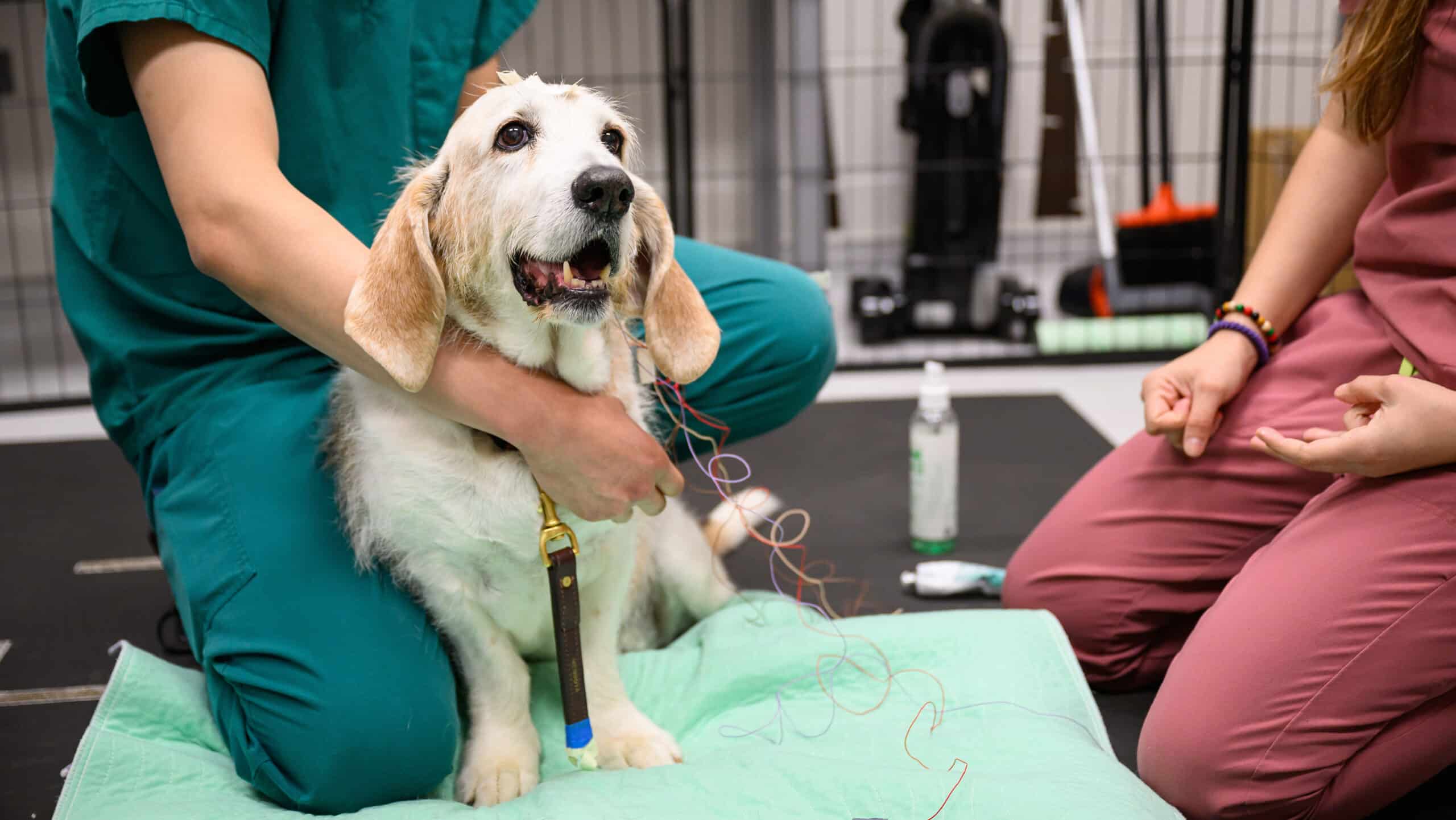New Study Looks at Role of Sleep Disruption in Dogs With Dementia

For Immediate Release
Dogs with dementia suffer the same sleep disruptions that humans with dementia do. In a new study, researchers from North Carolina State University performed electroencephalography, or EEGs, on elderly dogs to determine whether brain-wave readings during sleep correlated with signs of cognitive decline. They found that dogs with more advanced dementia suffered more sleep disruptions and slept less overall than dogs with normal cognitive function.
The study – part of an ongoing clinical trial on canine aging and cognition at NC State –looked at 28 elderly dogs: 17 females and 11 males. Prior to the sleep study, the dogs had received complete physicals, undergone cognitive testing, and their owners completed the Canine Dementia Scale (CADES) questionnaire, in order to determine the severity of their cognitive decline.
The researchers used non-invasive techniques to gather their data – the dogs weren’t sedated, and the electrodes were affixed to the skull with sticky gel. The dogs did two sleep sessions in the lab – the first one to acclimate them to the surroundings and electrode placement, and the second to record brain activity during a two hour sleep period.
“Past sleep studies in dogs often involved surgically implanted electrodes,” says Alejandra Mondino, postdoctoral researcher at NC State and lead author of the study. “Non-invasive studies are relatively new. We are one of a handful of groups doing this work.”
The EEG measured four stages of sleep: wakefulness, drowsiness, NREM and REM. NREM, or non-REM, is a deep sleep state prior to REM (which stands for rapid eye movement and is associated with dreaming).
“In NREM, the brain clears toxins, including the beta-amyloid proteins that are involved in diseases like Alzheimer’s,” Mondino says. “REM sleep is when dreams happen, and this stage is very important for memory consolidation.”
The researchers correlated the percentage of time spent in each sleep state with the dogs’ scores on cognitive testing and the CADES questionnaire. The higher the dog’s dementia score, the less time they spent in NREM and REM sleep.
“These dogs have dementia and sleep disruption is part of that,” Mondino says. “In addition to the shorter time spent sleeping, when we look at the EEG, we saw their brain activity during sleep was more akin to wakefulness.
“In other words, when they do manage to sleep, their brains aren’t really sleeping.”
The work is an important part of establishing baselines for identifying cognitive decline in dogs. The researchers hope that the work can lead to early diagnosis and intervention for elderly dogs with signs of cognitive decline.
“We now know that EEG signatures are useful indicators of canine cognitive dysfunction,” says Natasha Olby, the Dr. Kady M. Gjessing and Rahna M. Davidson Distinguished Chair in Gerontology at NC State and corresponding author of the study. “The work further establishes the dog as a model for Alzheimer’s disease. Hopefully therapeutic trials in dogs will help to direct our choices of treatment development for people.”
The work appears in Frontiers in Veterinary Science and was supported by the Kady M. Gjessing and Rahna M. Davidson Distinguished Chair in Gerontology, the Sleep Research Society Foundation (Grant 04-SRG-21) and the Company of Biologists (Grant DMMTF2205727).
-peake-
Note to editors: An abstract follows.
“Sleep and cognition in aging dogs. A polysomnographic study”
DOI: 10.3389/fvets.2023.1151266
Authors: Alejandra Mondino, Michael Khan, Claire Ludwig, Margaret Elizabeth Gruen and Natasha J. Olby, North Carolina State University; Magaly Catanzariti, Instituto de Matemática Aplicada del Litoral Santa Fe, Argentina; Diego Martin Mateos, Instituto de Matemática Aplicada del Litoral Santa Fe, Argentina and Universidad Autónoma de Entre Ríos (UADER), Entre Ríos, Argentina; Anna Kis, Research Centre for Natural Sciences, Institute of Cognitive Neuroscience and Psychology, Budapest, Hungary
Published: Apr. 28, 2023 in Frontiers in Veterinary Science
Abstract:
Introduction: Sleep is fundamental for cognitive homeostasis, especially in senior populations since clearance of amyloid beta (key in the pathophysiology of Alzheimer’s disease) occurs during sleep. Some electroencephalographic characteristics of sleep and wakefulness have been considered a hallmark of dementia. Owners of dogs with canine cognitive dysfunction syndrome (a canine analog to Alzheimer’s disease) report that their dogs suffer from difficulty sleeping. The aim of this study was to quantify age-related changes in the sleep-wakefulness cycle macrostructure and electroencephalographic features in senior dogs and to correlate them with their cognitive performance.
Methods: We performed polysomnographic recordings in 28 senior dogs during a 2 h afternoon nap. Percentage of time spent in wakefulness, drowsiness, NREM, and REM sleep, as well as latency to the three sleep states were calculated. Spectral power, coherence, and Lempel Ziv Complexity of the brain oscillations were estimated. Finally, cognitive performance was evaluated by means of the Canine Dementia Scale Questionnaire and a battery of cognitive tests. Correlations between age, cognitive performance and sleep-wakefulness cycle macrostructure and electroencephalographic features were calculated.
Results: Dogs with higher dementia scores and with worse performance in a problem-solving task spent less time in NREM and REM sleep. Additionally, quantitative electroencephalographic analyses showed differences in dogs associated with age or cognitive performance, some of them reflecting shallower sleep in more affected dogs.
Discussion: Polysomnographic recordings in dogs can detect sleep-wakefulness cycle changes associated with dementia. Further studies should evaluate its potential clinical use to monitor the progression of canine cognitive dysfunction syndrome.


